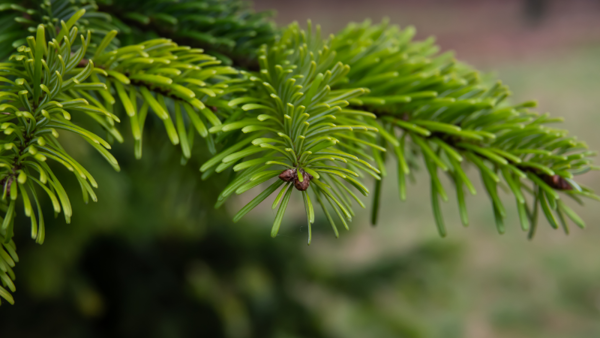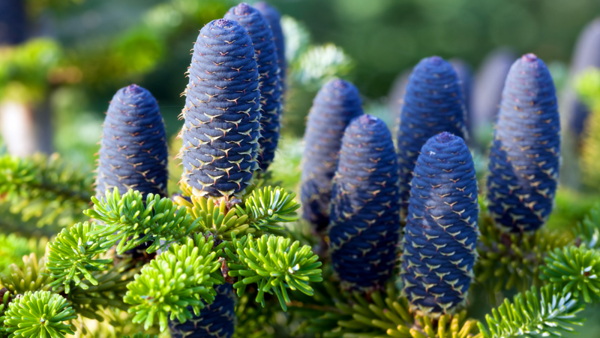Yates Account
Join now
Create a Yates account today!
Sign up to join the Yates Garden Club for monthly e-mails packed with seasonal inspiration, tips for success & exclusive promotions.
Plus if you’re a Garden Club member you can take part in the Yates Growing Community - a blog to share successes, get advice & win prizes in fun challenges along the way!

Forgot password
Enter the email address associated with your account, and we'll email you a new password.

Abies, also known as Fir Trees, are evergreen coniferous shrubs and trees. The highly structured branching and conical shape makes them a great candidate for a Christmas tree! A species called Korean Fir (Abies koreana) is suitable for small gardens, with a mature height of 4-9m and even for planting in pots. Needle-like leaves come in shades of silver-green, blue-green and lime-green. The upright cones are particularly attractive which come in various colours and sizes depending on the species and cultivars.
How to grow Abies in a garden
Be sure to choose a variety which is suitable to the size of your garden.
- Choose a position in full sun or part shade with well drained soil.
- Enrich the soil with Yates Thrive Natural Blood & Bone with Seaweed. If the soil is clay based, add gypsum and fork in well.
- Dig the planting hole twice as wide and to the same depth as the root-ball. Remove the plant from the container and gently tease the roots.
- Position in hole and backfill, gently firming down. Form a raised ring around the plant, creating a well so that water will go where it’s needed most. Water in well.
- Mulch with an organic mulch like woodchip or pea straw, keeping it away from the base of the plant.
- Water deeply, once or twice a week, depending on weather conditions.
- Feed with Yates Thrive All Purpose Granular Plant Food. TIP: for an added boost apply Yates Thrive Fish Blood & Bone Plant Food Concentrate.


How to grow Abies in a pot
Dwarf varieties are ideal for pots, whereas tree varieties can be used for temporary plant displays - when the plant outgrows the pot, plant in the garden.
- Choose a pot at least 250mm wide with adequate drainage holes.
- Position in full sun or part shade and fill with quality potting mix, such as Yates Premium Potting Mix.
- Remove the plant from the container and gently tease the roots.
- Position in hole and backfill, gently firming down. Water in well.
- Water deeply, once or twice a week, depending on weather conditions.
- Feed with Yates Thrive All Purpose Liquid Plant Food. TIP: for an added boost, apply Yates Thrive Fish Blood & Bone Plant Food Concentrate.
Growing tips
- Most Abies prefer an acidic to mostly neutral soil pH. Check the soil pH prior to planting using a soil pH test kit. If the soil pH is greater than 7.0 apply Yates Soil Acidifier Liquid Sulfur. If the soil pH is less than 5.0 apply Yates Hydrangea Pinking Liquid Lime & Dolomite.
- Some varieties include:
- Himalayan Fir (Abies spectabilis)
- Fraser Fir (Abies fraseri)
- Korean Fi (Abies koreana)
- Golden Korean Fir (Abies koreana 'Aurea')
- Silver Snow Korean Fir (Abies koreana "Silver Snow")
- Cilician Fir (Abies cilicica)
- Caucasian Fir (Abies normanniana)
- To maintain their natural conical shape, avoid pruning these trees as they do not respond well to pruning.
Japanese maples, also known as Acers, are attractive trees with stunningly vibrant autumn and spring foliage. Some varieties have brightly coloured bark & stems.
Dwarf Pōhutukawa
Dwarf Pōhutukawa (AKA Pacific Rata or Tahitian Pohutukawa) is a fantastic flowering shrub or small tree ideal for use as a feature plant, hedge or screen.
Daphne
Daphne is an evergreen shrub with glossy green leaves and beautifully fragrant flowers in shades of white and pink. Grow in the garden or in pots.
Smoke Bush
Smoke Bush is an ideal shrub to add a splash of foliage colour to gardens. It provides year-round seasonal interest and looks fabulous in both gardens and pots.
Recommended products
Yates Thrive All Purpose Granular Plant Food
Easy-to-use granular plant food specially formulated with both fast acting and gradual feeding for up to 3 months, in the garden or pots.
Yates Thrive All Purpose Liquid Plant Food
A liquid plant food suitable for most types of plants and provides balanced feeding to promote stronger, healthier growth and greener foliage. Feeds through the leaves and roots for fast results.
Yates Thrive Natural Blood & Bone with Seaweed
A certified organic garden input boosted with NZ Seaweed to gently nourish plants, enrich the soil and encourage a strong healthy root system.
Yates Premium Potting Mix
A premium potting mix, ideal for all potted plants and shrubs, including ornamentals, fruit trees, vegies and herbs.
















Share
Share this article on social media